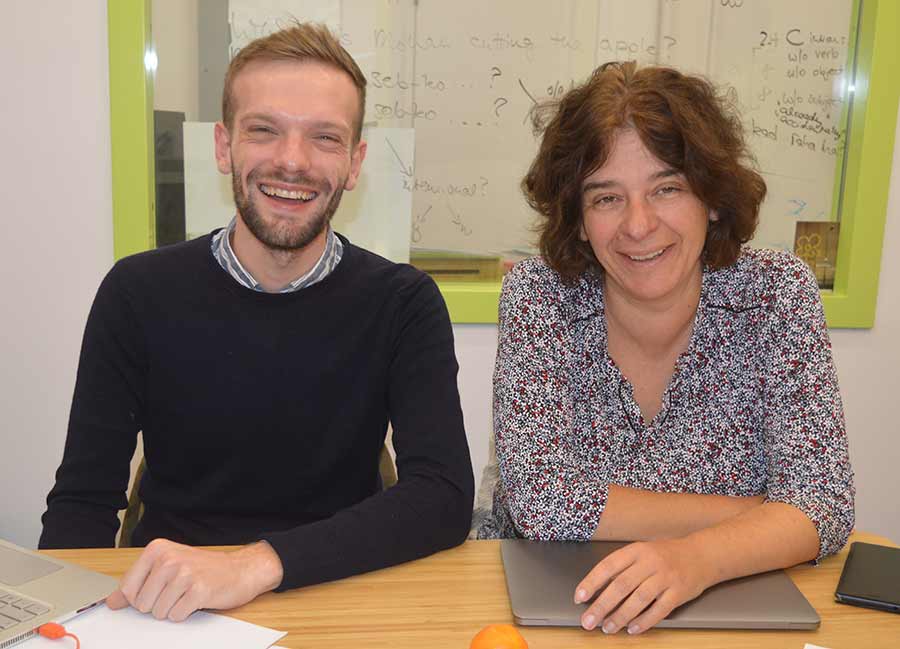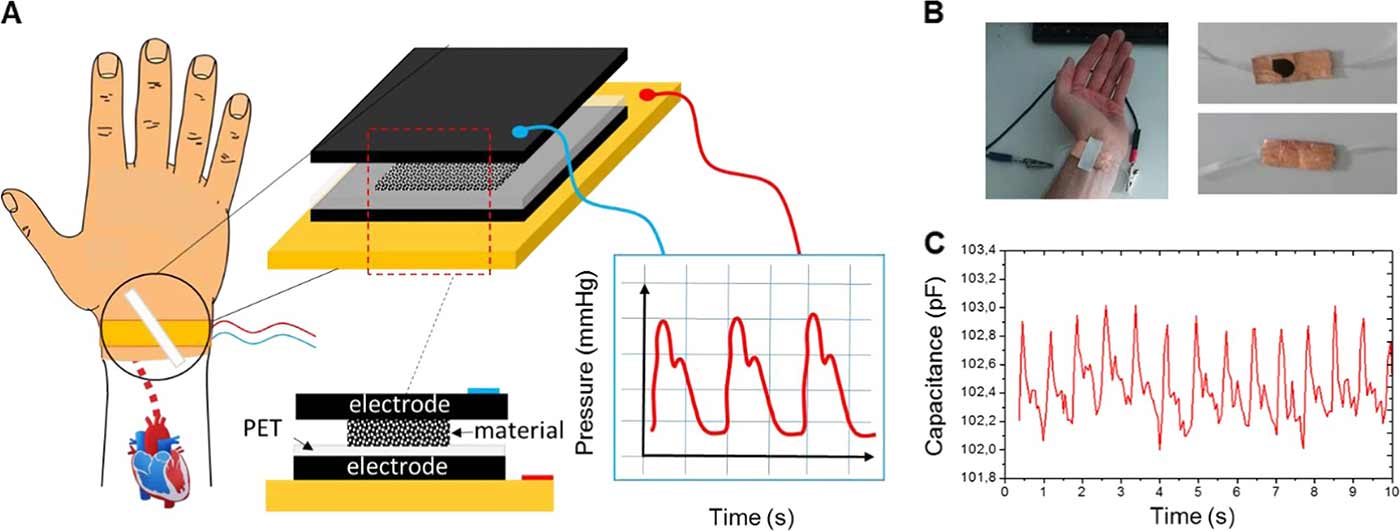
By:
- Lisa Petrillo
Published Date
By:
- Lisa Petrillo
Share This:
Burbidge Visiting Professor Uses Physics of Mayonnaise to Develop Electronic Skin

Annie Colin (right) pictured with her ESPCI postdoctoral fellow Mickael Pruvost in the Language Comprehension Lab at UC San Diego. Photo by Lisa Petrillo.
For researcher Annie Colin, a Margaret Burbidge Visiting Professor at the University of California San Diego, the road to developing better electronic skin is all about the physics of mayonnaise.
The professor from École Supérieure de Physiques et de Chimie Industrielle (ESPCI) in France has been captivated by that magic “mayo” bonding between egg and oil since she was a student in Paris. Mayonnaise is, after all, a perfectly edible expression of soft matter science, which Collin applies to developing “e-skin”—a hot area of study in pursuit of applications like more responsive prosthetics for human-robot interfaces and pressure sensors to prevent necrosis in diabetic patients and ulcers in paraplegics.
With a shared passion for what Jérémie Palacci, an assistant professor in the UC San Diego Department of Physics, calls “the science of squishy things,” he and Colin are working on a project to apply her research results to materials that would heal similar to wounds. Palacci’s contribution stems from his study of the ability of seemingly primitive building blocks to organize in complex patterns and robust machineries.
The ‘squishy science’ of e-skin
Soft matter—a branch of condensed matter physics—is ubiquitous and people use it every day in things like toothpaste, paint, cement, and, of course, mayonnaise. It’s a field dedicated to figuring out how solid and liquids flow, or keeping your paint nice and smooth or your panna cotta the right texture. Recently, it delved into the development of multifunctional wearable sensors.
Colin has parlayed her soft matter science into multiple patents related to paper-thin flexible devices sensitive enough to monitor the human heartrate, and to research that has recently led to a notable advance in developing e-skin. Together with a trio of colleagues from the French National Centre for Scientific Research, Colin recently published a journal article spotlighted as a major advance in creating a tough but sensitive flexible polymer—a material made of long, repeating molecule chains—that works as a new kind of e-skin, significantly more sensitive than what has been achieved before.

This figure shows: A. Schematic illustration of the capacitive pressure sensor. B. The pressure sensor attached to the wrist of a person. C. Real-time and in-situ capacitive signal of the artery wrist pulse recorded. The recorded wave signal corresponds to the typical human waveform. Figure courtesy of the research team at ESPCI
“The high-pressure sensitivity of our material could pave the way of artificial skin rivaling with human skin,” Colin and her co-authors note in their article, “Polymeric foams for flexible and highly sensitive low-pressure capacitive sensors,” published in the Nature-portfolio journal NPJ Flexible Electronics.
According to Colin, the scientific and engineering challenge has been creating scalable, efficient and robust e-skin that is flexible, sensitive and easy to produce at low cost and to efficiently monitor electronically. To do this, she and her fellow researchers at the Chemistry Biology Innovation Institute (Insitut Chimie Biologie Innovation) at ESPCI use what they call “an unconventional composite material capacitive sensor,” based on composite foam materials filled with conductive carbon black particles.
The key to this “mayo” approach is using polydimethylsiloxane (PDMS) porous materials to design solid foams that enhance the responsiveness to mechanical pressure. The secret sauce ingredient is a silicon-based organic polymer, known for its unusual flow properties. The researchers coat the material in carbon black conductive particles—like black polka dots on otherwise translucent white silicone-looking shapes. The resulting sensitivity, according to Colin and colleagues, is at least 70 times greater than previously reported values without relying on electronic amplification.
“These materials pave the road for the implementation of e-skin in commercialized applications,” noted the researchers.
Spreading impact through collaboration
The physics of mayonnaise is spreading Colin’s impact as an inaugural Burbidge Visiting Professor—an initiative supported by the Heising-Simons Foundation and named for UC San Diego’s trailblazing astrophysicist and emerita professor Margaret Burbidge—through research collaborations. Such interdisciplinary scholarship is at the heart of UC San Diego’s research excellence since solutions to the most challenging research problems require the collective talents of groups of investigators with a range of disciplinary skills.
One of Colin’s most active collaborations is with Eva Wittenberg, assistant professor in the Department of Linguistics in the UC San Diego Division of Social Sciences. Together they are exploring how to adapt the mayonnaise-inspired flexible sensors to a simple pen that could potentially work in a number of applications, from research in cognitive psychology to applications in education and medicine. This research is funded by Labex, Pierre-Gilles de Gennes Institute (IPGG).

(Left to right): Assistant Professor Eva Wittenberg, linguistics; Mickael Pruvost, French postdoctoral fellow at ESPCI Paris and Annie Colin examine data from testing the pen. Photo by Lisa Petrillo
“There are a lot of different potential applications,” said Wittenberg, who is currently testing and benchmarking the pen in her lab, the Language Comprehension Lab. “There are rehabilitation perspectives, but there are also very interesting research perspectives, including in my area of language processing.”
Working with Dan Grober, a graduate student in Palacci's Materiali Molli Lab, Colin is studying the effect of activity injected from within by microscopic entities on the mechanical behavior of very weak gels. Specifically, the researchers are looking to discover if this added energy, coming from active matter, allows the weak gel to flow more easily, making it possible to self-heal after fracture, a phenomenon speculated to be important in the recovery of tissue wounds.
“So far, I have found the results from our collaboration very promising, and we will continue our research collaboration long after Professor Colin leaves our sunny corner of California,” Palacci said.
Colin, whose collaborating continues from France now, agreed. “I had a very enjoyable and exciting time in terms of research in San Diego, and I hope to continue working with all the teams,” she said.
The purpose of the Margaret Burbidge Visiting Professorship is to bring eminent female physicists to UC San Diego on a short-term basis for collaborative research interactions within the Department of Physics and across the university. The Division of Physical Sciences’ graduate program in physics is among the Top 20 offered in the nation, according to U.S. News & World Report’s education rankings.
Share This:
You May Also Like
Stay in the Know
Keep up with all the latest from UC San Diego. Subscribe to the newsletter today.


